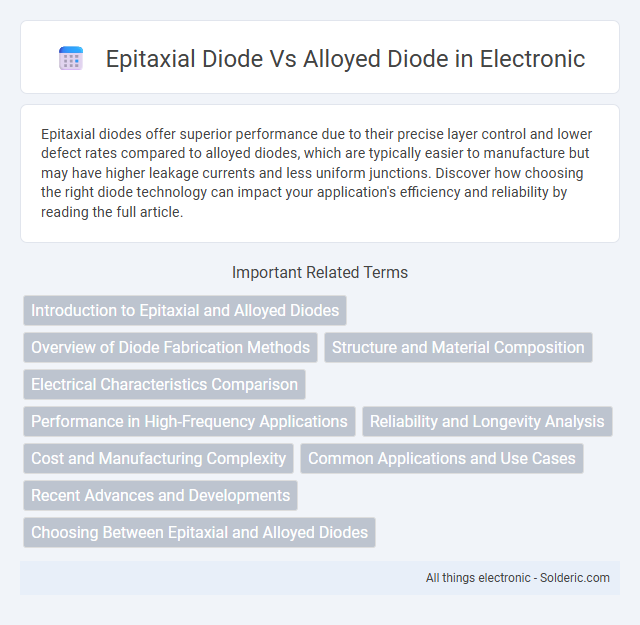Epitaxial diodes offer superior performance due to their precise layer control and lower defect rates compared to alloyed diodes, which are typically easier to manufacture but may have higher leakage currents and less uniform junctions. Discover how choosing the right diode technology can impact your application's efficiency and reliability by reading the full article.
Comparison Table
| Feature | Epitaxial Diode | Alloyed Diode |
|---|---|---|
| Manufacturing Process | Layer deposition on substrate via epitaxy | Metal alloy fused into semiconductor substrate |
| Junction Formation | Precisely controlled epitaxial layer doping | Formed by melting alloy metal into semiconductor |
| Performance | Higher frequency response and lower leakage | Lower frequency limits, higher leakage |
| Reliability | Improved stability and reproducibility | Less consistent due to alloy diffusion |
| Cost | Higher due to complex epitaxial process | Lower manufacturing cost |
| Applications | High-speed, high-frequency circuits | Standard rectification and low-frequency use |
Introduction to Epitaxial and Alloyed Diodes
Epitaxial diodes are fabricated using a controlled layer-by-layer deposition of semiconductor material on a substrate, resulting in a high-purity, low-defect crystal structure that enhances electrical performance and reliability. Alloyed diodes are produced by fusing a metal alloy onto a semiconductor substrate, creating a junction through diffusion, which is a simpler and cost-effective process but often leads to higher defect densities and reduced precision. The epitaxial process allows for better control over doping profiles and junction depth, making epitaxial diodes suitable for high-frequency and high-power applications compared to alloyed diodes.
Overview of Diode Fabrication Methods
Epitaxial diode fabrication involves depositing a single-crystal semiconductor layer on a substrate, enabling precise control of electrical properties and junction depths for high-performance applications. Alloyed diode fabrication relies on melting and diffusing metal alloy contacts into the semiconductor, offering simplicity but less control over junction characteristics. Your choice between epitaxial and alloyed diodes influences device uniformity, response time, and overall efficiency in semiconductor circuits.
Structure and Material Composition
Epitaxial diodes feature a precise, layered semiconductor structure where a thin epitaxial layer is deposited on a substrate, allowing for better control of doping and junction properties, which enhances performance in high-frequency and high-power applications. Alloyed diodes consist of a bulk semiconductor base where the junction is formed by alloying a metal or semiconductor contact, resulting in a less uniform structure with higher junction capacitance and slower switching speeds. Your choice between these diodes impacts device efficiency and response time, driven primarily by their distinct material composition and junction formation techniques.
Electrical Characteristics Comparison
Epitaxial diodes exhibit lower reverse leakage current and higher breakdown voltage due to the controlled epitaxial layer, resulting in improved performance in high-frequency and high-voltage applications. Alloyed diodes typically have higher forward voltage drops and increased junction capacitance, limiting their efficiency and switching speed. The precise structure of epitaxial diodes allows for better electrical characteristics such as reduced series resistance and enhanced thermal stability compared to alloyed diodes.
Performance in High-Frequency Applications
Epitaxial diodes exhibit superior performance in high-frequency applications due to their lower junction capacitance and faster switching speeds compared to alloyed diodes. The epitaxial layer allows for precise control of doping profiles, reducing charge storage and enhancing frequency response. Alloyed diodes typically suffer from higher parasitic capacitance and slower recovery times, limiting their effectiveness in RF and microwave circuits.
Reliability and Longevity Analysis
Epitaxial diodes exhibit higher reliability and longer operational lifespan compared to alloyed diodes due to their superior crystal quality and controlled doping profiles. The epitaxial layer reduces defects and enhances thermal stability, making your circuits more dependable under varying environmental conditions. Alloyed diodes, while cost-effective, often suffer from increased leakage currents and faster degradation rates, limiting their longevity in demanding applications.
Cost and Manufacturing Complexity
Epitaxial diodes generally incur higher manufacturing costs due to the precise layer deposition and stringent cleanroom conditions required for epitaxial growth, which demand advanced equipment and processes. Alloyed diodes are more cost-effective to produce as they utilize simpler fabrication techniques involving the alloying of metals onto semiconductor substrates, resulting in lower material and production expenses. Your choice depends on balancing the higher performance and precision of epitaxial diodes against the affordability and ease of manufacturing alloyed diodes.
Common Applications and Use Cases
Epitaxial diodes are commonly used in high-frequency and high-speed switching applications such as RF circuits, microwave devices, and power amplifiers due to their low capacitance and superior switching characteristics. Alloyed diodes are preferred for power rectification and general-purpose circuits where ruggedness and cost-effectiveness are essential, such as in power supplies and automotive electronics. Your choice between epitaxial and alloyed diodes depends on the specific performance requirements and operating conditions of the application.
Recent Advances and Developments
Recent advances in epitaxial diode technology have significantly improved carrier mobility and reduced leakage currents due to advancements in epitaxial layer growth techniques such as molecular beam epitaxy (MBE) and metal-organic chemical vapor deposition (MOCVD). Alloyed diodes have seen developments in material composition and precise thermal alloying processes, enhancing junction quality and thermal stability for high-power applications. Your choice between epitaxial and alloyed diodes can now be better informed by performance improvements driven by these modern fabrication methods.
Choosing Between Epitaxial and Alloyed Diodes
Choosing between epitaxial diodes and alloyed diodes depends on your application's requirements for performance and reliability. Epitaxial diodes offer superior uniformity, lower leakage current, and faster switching speeds, making them ideal for high-frequency and precision circuits. Alloyed diodes, while more cost-effective and easier to manufacture, typically exhibit higher series resistance and are better suited for general-purpose and lower-frequency uses.
Epitaxial diode vs Alloyed diode Infographic

 solderic.com
solderic.com